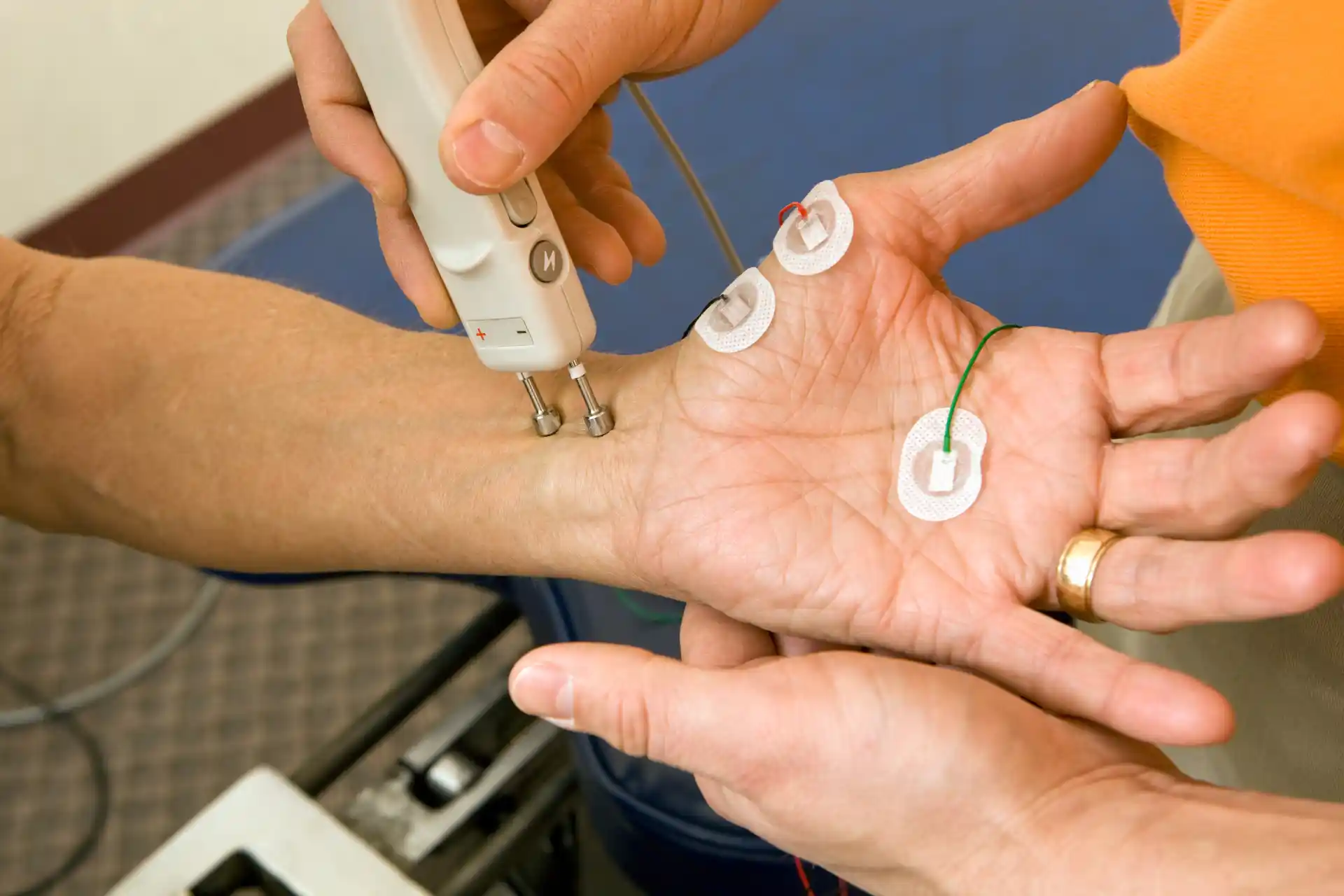Understanding Median Nerve Compression
You may feel tingling, numbness, or a dull ache in your hand and wrist that just won’t quit. Often, these are signs of median nerve compression, where the nerve that travels through your wrist’s carpal tunnel is under pressure.
Good news, though, many everyday steps can help relieve discomfort and protect your nerve function.
Below are eight simple ideas you can try today, based on a blend of expert research and friendly guidance.
1. Recognize Early Signs
Spotting hand and wrist issues early makes all the difference. When the median nerve is squeezed, you might notice:
- Numbness, especially in your thumb, index, or middle finger
- Tingling or a pins-and-needles feeling (often called paresthesia)
- Weak grip or difficulty lifting small items
- Discomfort that wakes you up at night
If you do feel these symptoms, try gently bending or stretching your wrists for short relief.
Keep an eye out for other hints too. For instance, if your little finger feels numb, you might be dealing with ulnar tunnel syndrome, rather than the classic carpal tunnel syndrome.
Either way, noticing the pattern helps you decide your next move, like adjusting your daily habits or seeking medical advice.
2. Adjust Your Workspace
Daily tasks can aggravate median nerve compression if your wrists are forced to bend over and over. A few ergonomic tweaks often go a long way:
- Position your keyboard so your wrists stay neutral (not tilted up or down)
- Set your chair height to keep forearms parallel to the floor
- Use a mouse that fits your hand, not too bulky or cramped
These steps reduce strain, especially if you spend hours typing or clicking. Repeated wrist movements can ramp up pressure on the nerve in the carpal tunnel (Mayo Clinic).
That’s why getting the setup right matters. You’ll free your wrists and lower your chance of burning pain by the afternoon.
3. Take Regular Breaks
When you’re deep in a project, it’s easy to forget to pause. However, tiny breaks can help calm the inflammation behind nerve compression:
- Every 30 to 60 minutes, stand up and stretch your arms.
- Gently bend your palms forward and back.
- Roll your shoulders to release tension from your neck and upper back.
Studies indicate that tasks involving high-force, repetitive hand movements can lead to an increased risk of nerve compression syndrome (NCBI PMC).
You’ll give your body a chance to rest and reset, cutting down on repetitive stress that aggravates the median nerve.
4. Use Supportive Braces
A brace can help position your wrist in a neutral stance, lowering pressure on the nerve.
A carpal tunnel brace might be especially helpful overnight, when some people unconsciously curl their wrists inward, intensifying pain. It can also help if your job involves vibration or forceful gripping.
If you find that your elbow area aches or you have numbness shooting up the forearm, talk with your doctor about a cubital tunnel syndrome brace. Cubital tunnel syndrome affects the ulnar nerve at the elbow, but sometimes the pain pattern overlaps with median nerve symptoms.
A brace eases tension by keeping your arm in a comfortable position, letting irritated tissues calm down and heal.
5. Try Gentle Exercises
Simple hand and wrist movements can promote blood flow and relieve built-up tension. For instance, you can do carpal tunnel exercises at home.
They often include:
- Wrist Flexion and Extension: Gently bring your palm down and then up.
- Finger Spreads: Touch each fingertip to your thumb, then open and close your hand.
- Wrist Rotations: Make a loose fist, rotate clockwise for five rotations, then counterclockwise.
Whenever possible, focus on smooth, unhurried motions. Studies found that combining small daily exercises with other therapies (like bracing) can speed up symptom relief (Medscape).
Good news, these moves only take a few minutes a day and fit easily into a morning or evening routine.
6. Maintain Good Posture
Sitting tall benefits more than your back. Slouched shoulders or a hunched spine can affect how your arms, wrists, and hands align.
Over time, poor posture may create unwanted tension that filters into the wrist, placing stress on your median nerve.
A few quick checkpoints:
- Keep your shoulders relaxed, not hunched or pulled backward too far
- Position monitors at eye level to prevent forced neck angles
- Let your elbows hang close to the body, near a 90-degree angle
Studies have shown that awkward wrist angles and drooping shoulders can aggravate nerve compression (NCBI PMC).
A supportive chair and a mindful approach can encourage better alignment and less pain for the future.
7. Consider Conservative Therapies
If you’ve tried small lifestyle tweaks and still feel lingering discomfort, it might be time to explore slight but effective therapies.
These treatment options should be treated as a general guideline, always consult with a healthcare professional for personalized guidance on nerve compression treatment that is right for you.
- NSAIDs (like ibuprofen) for short-term pain relief
- Occupational therapy, which includes stretches, posture training, and wrist splinting
- Corticosteroid injections to reduce inflammation around the median nerve (NYU Langone Health)
In many cases, these steps lessen swelling and friction. People with mild to moderate issues often see improved function without needing surgery.
If you experience symptom relief, continue with the recommended steps 1-6 above, as repetitive motions or poor posture could spark another flare-up in the future.
8. Know When To Seek Help
Sometimes, advanced compression requires more than splints or rest. If you’ve tried the basics for months but still have constant numbness or pain radiating up your forearm, it might be time for a deeper evaluation.
A medical professional can recommend tests, such as a carpal tunnel syndrome test or imaging, to confirm that you have median nerve trouble and not a median nerve injury that needs urgent attention.
Should you need a procedure, carpal tunnel surgery is often done to free the trapped nerve. Check out our dedicated article on carpal tunnel surgery to learn more.
Keep in mind, nobody’s path to healing is identical, so a thorough chat with your care team is key.
9. Seek RELIEF®
RELIEF® is a science-backed, targeted approach that targets dysfunctional fascia—connective tissue that may contribute to nerve compression.
Using a minimally invasive technique called hydrodissection, RELIEF® releases stuck or adhered layers of fascia and soft tissue. This process may help relieve the tingling, numbness, and pain often associated with conditions like carpal or cubital tunnel syndrome.1,2,3,4,5,6
Read more on other conditions caused by nerve compression or damage such as nerve entrapment, sciatica and piriformis syndrome.
Final Takeaway
Pick one or two strategies to start with, and then build from there. Consistency is what ultimately makes a difference in calming median nerve compression.
A small daily habit change can make a major impact on your comfort and mobility. If your symptoms persist, don’t hesitate—talk with a healthcare provider about next steps.
RELIEF® is a science-backed, targeted approach that targets dysfunctional fascia—connective tissue that may contribute to nerve compression.
If you are in the area and looking for a Miami hand and wrist pain specialist, contact us today to schedule a consultation and learn more about how RELIEF® may help with compressed nerves and cubital/carpal tunnel symptoms.






.svg)